Bioinformatics: Genomics Medicine Case Review and Analysis Report
VerifiedAdded on 2022/08/16
|16
|5272
|19
Report
AI Summary
This report provides a comprehensive analysis of a genomics medicine case study involving a 15-year-old boy, Roger, diagnosed with mild-to-moderate intellectual disability. The analysis begins with a critical discussion of key information from Roger's family history, including his father's pancreatic cancer and his sister's child born with polydactyly, and their significance in understanding potential genetic factors. A pedigree chart is constructed and interpreted to visualize the family's genetic inheritance patterns. The report then explores the likely mode of inheritance for Roger's disorder, emphasizing the role of genetic mutations. The application of genomic sequencing in this case is explained, highlighting its utility in identifying the underlying genetic causes of Roger's condition. Part B delves into the specifics of Roger's human genome sequencing results, focusing on the critical assessment of three identified variants, including their molecular biological consequences, allele frequencies, and likely pathogenicity, particularly concerning the CEP290 gene and associated disorders. The report also discusses the clinical implications of these variants.
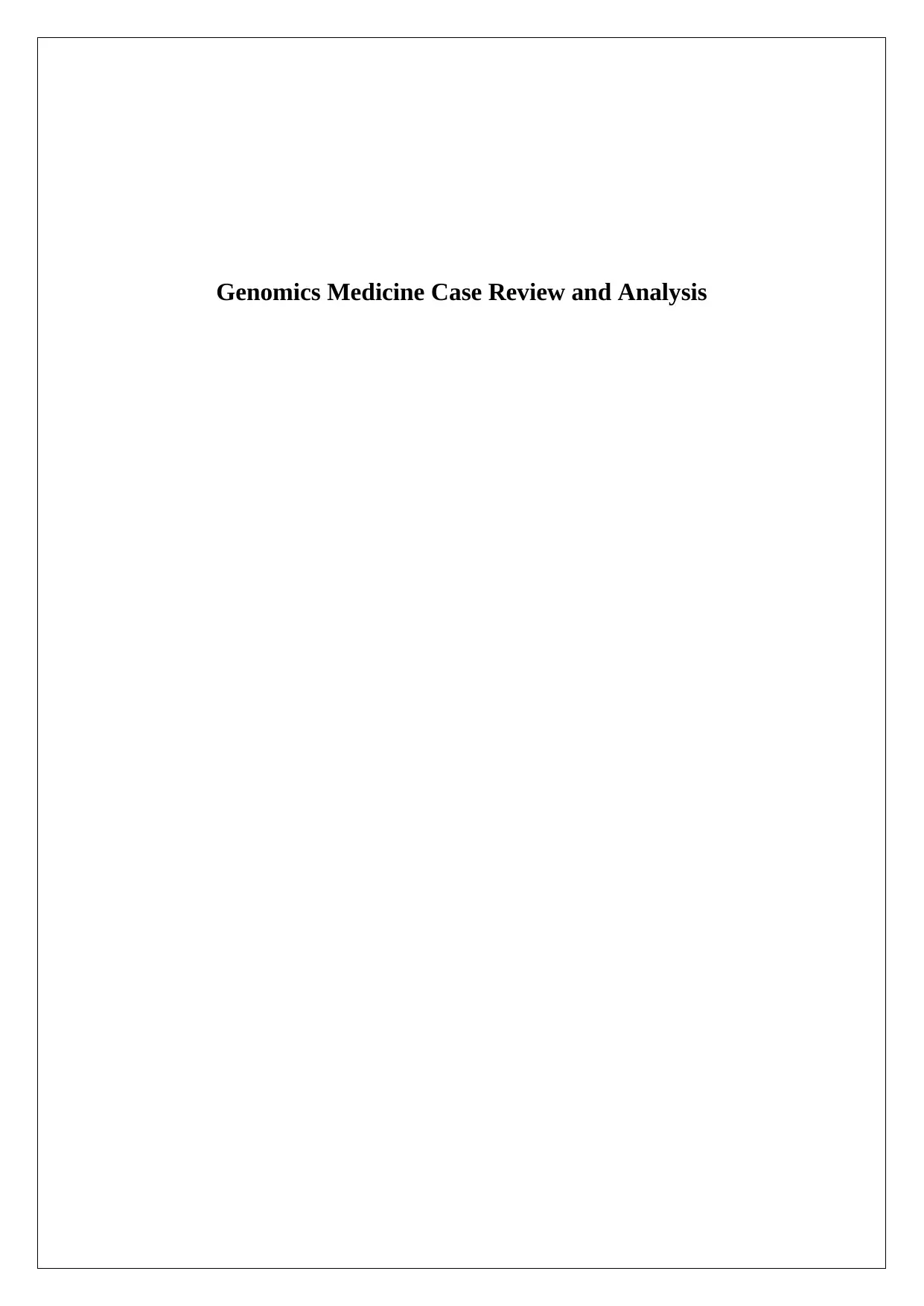
Genomics Medicine Case Review and Analysis
Paraphrase This Document
Need a fresh take? Get an instant paraphrase of this document with our AI Paraphraser

Table of Contents
Introduction................................................................................................................................3
Part A.........................................................................................................................................3
Part B..........................................................................................................................................6
Conclusion................................................................................................................................12
Reference List..........................................................................................................................13
2
Introduction................................................................................................................................3
Part A.........................................................................................................................................3
Part B..........................................................................................................................................6
Conclusion................................................................................................................................12
Reference List..........................................................................................................................13
2
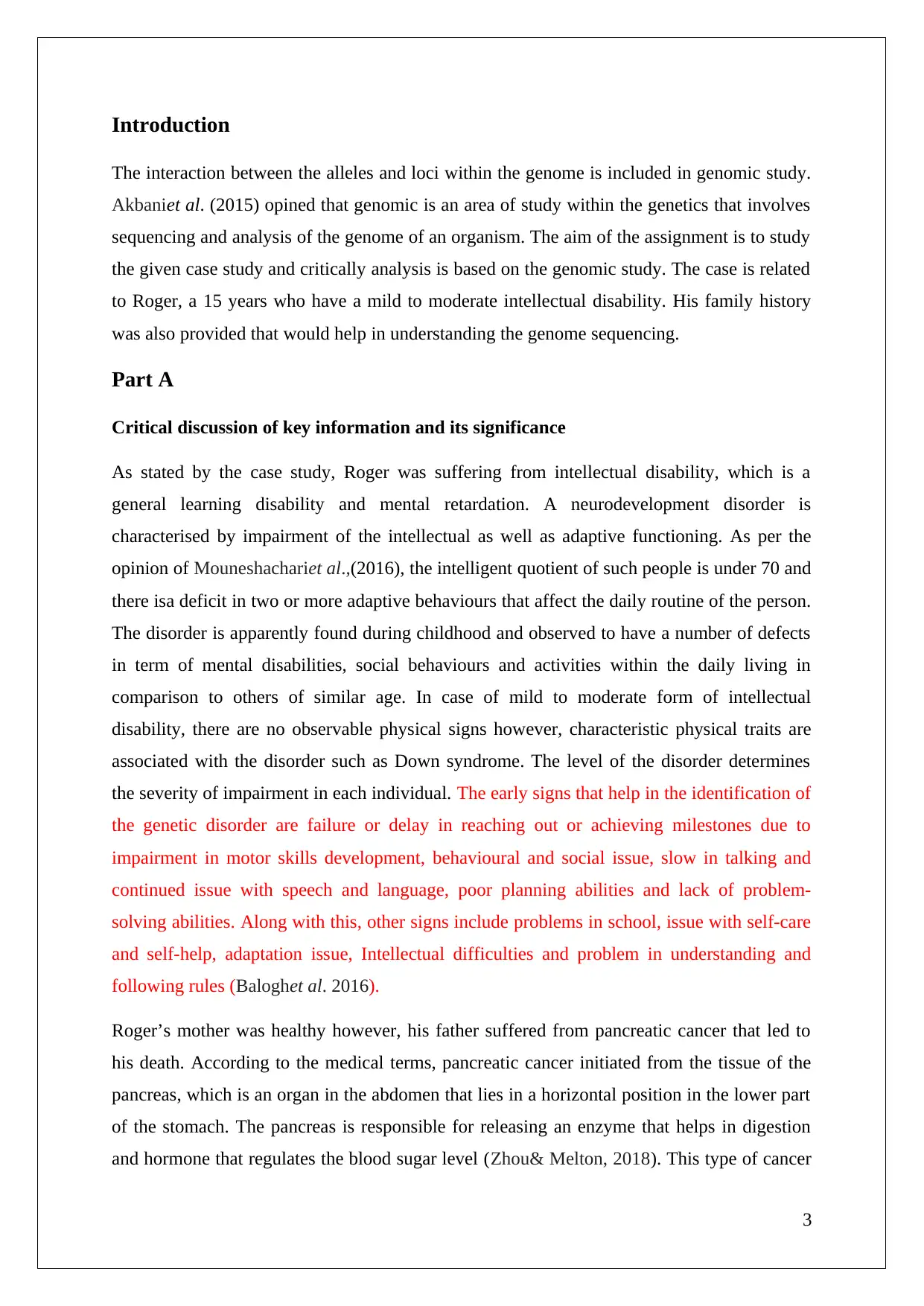
Introduction
The interaction between the alleles and loci within the genome is included in genomic study.
Akbaniet al. (2015) opined that genomic is an area of study within the genetics that involves
sequencing and analysis of the genome of an organism. The aim of the assignment is to study
the given case study and critically analysis is based on the genomic study. The case is related
to Roger, a 15 years who have a mild to moderate intellectual disability. His family history
was also provided that would help in understanding the genome sequencing.
Part A
Critical discussion of key information and its significance
As stated by the case study, Roger was suffering from intellectual disability, which is a
general learning disability and mental retardation. A neurodevelopment disorder is
characterised by impairment of the intellectual as well as adaptive functioning. As per the
opinion of Mouneshachariet al.,(2016), the intelligent quotient of such people is under 70 and
there isa deficit in two or more adaptive behaviours that affect the daily routine of the person.
The disorder is apparently found during childhood and observed to have a number of defects
in term of mental disabilities, social behaviours and activities within the daily living in
comparison to others of similar age. In case of mild to moderate form of intellectual
disability, there are no observable physical signs however, characteristic physical traits are
associated with the disorder such as Down syndrome. The level of the disorder determines
the severity of impairment in each individual. The early signs that help in the identification of
the genetic disorder are failure or delay in reaching out or achieving milestones due to
impairment in motor skills development, behavioural and social issue, slow in talking and
continued issue with speech and language, poor planning abilities and lack of problem-
solving abilities. Along with this, other signs include problems in school, issue with self-care
and self-help, adaptation issue, Intellectual difficulties and problem in understanding and
following rules (Baloghet al. 2016).
Roger’s mother was healthy however, his father suffered from pancreatic cancer that led to
his death. According to the medical terms, pancreatic cancer initiated from the tissue of the
pancreas, which is an organ in the abdomen that lies in a horizontal position in the lower part
of the stomach. The pancreas is responsible for releasing an enzyme that helps in digestion
and hormone that regulates the blood sugar level (Zhou& Melton, 2018). This type of cancer
3
The interaction between the alleles and loci within the genome is included in genomic study.
Akbaniet al. (2015) opined that genomic is an area of study within the genetics that involves
sequencing and analysis of the genome of an organism. The aim of the assignment is to study
the given case study and critically analysis is based on the genomic study. The case is related
to Roger, a 15 years who have a mild to moderate intellectual disability. His family history
was also provided that would help in understanding the genome sequencing.
Part A
Critical discussion of key information and its significance
As stated by the case study, Roger was suffering from intellectual disability, which is a
general learning disability and mental retardation. A neurodevelopment disorder is
characterised by impairment of the intellectual as well as adaptive functioning. As per the
opinion of Mouneshachariet al.,(2016), the intelligent quotient of such people is under 70 and
there isa deficit in two or more adaptive behaviours that affect the daily routine of the person.
The disorder is apparently found during childhood and observed to have a number of defects
in term of mental disabilities, social behaviours and activities within the daily living in
comparison to others of similar age. In case of mild to moderate form of intellectual
disability, there are no observable physical signs however, characteristic physical traits are
associated with the disorder such as Down syndrome. The level of the disorder determines
the severity of impairment in each individual. The early signs that help in the identification of
the genetic disorder are failure or delay in reaching out or achieving milestones due to
impairment in motor skills development, behavioural and social issue, slow in talking and
continued issue with speech and language, poor planning abilities and lack of problem-
solving abilities. Along with this, other signs include problems in school, issue with self-care
and self-help, adaptation issue, Intellectual difficulties and problem in understanding and
following rules (Baloghet al. 2016).
Roger’s mother was healthy however, his father suffered from pancreatic cancer that led to
his death. According to the medical terms, pancreatic cancer initiated from the tissue of the
pancreas, which is an organ in the abdomen that lies in a horizontal position in the lower part
of the stomach. The pancreas is responsible for releasing an enzyme that helps in digestion
and hormone that regulates the blood sugar level (Zhou& Melton, 2018). This type of cancer
3
⊘ This is a preview!⊘
Do you want full access?
Subscribe today to unlock all pages.

Trusted by 1+ million students worldwide
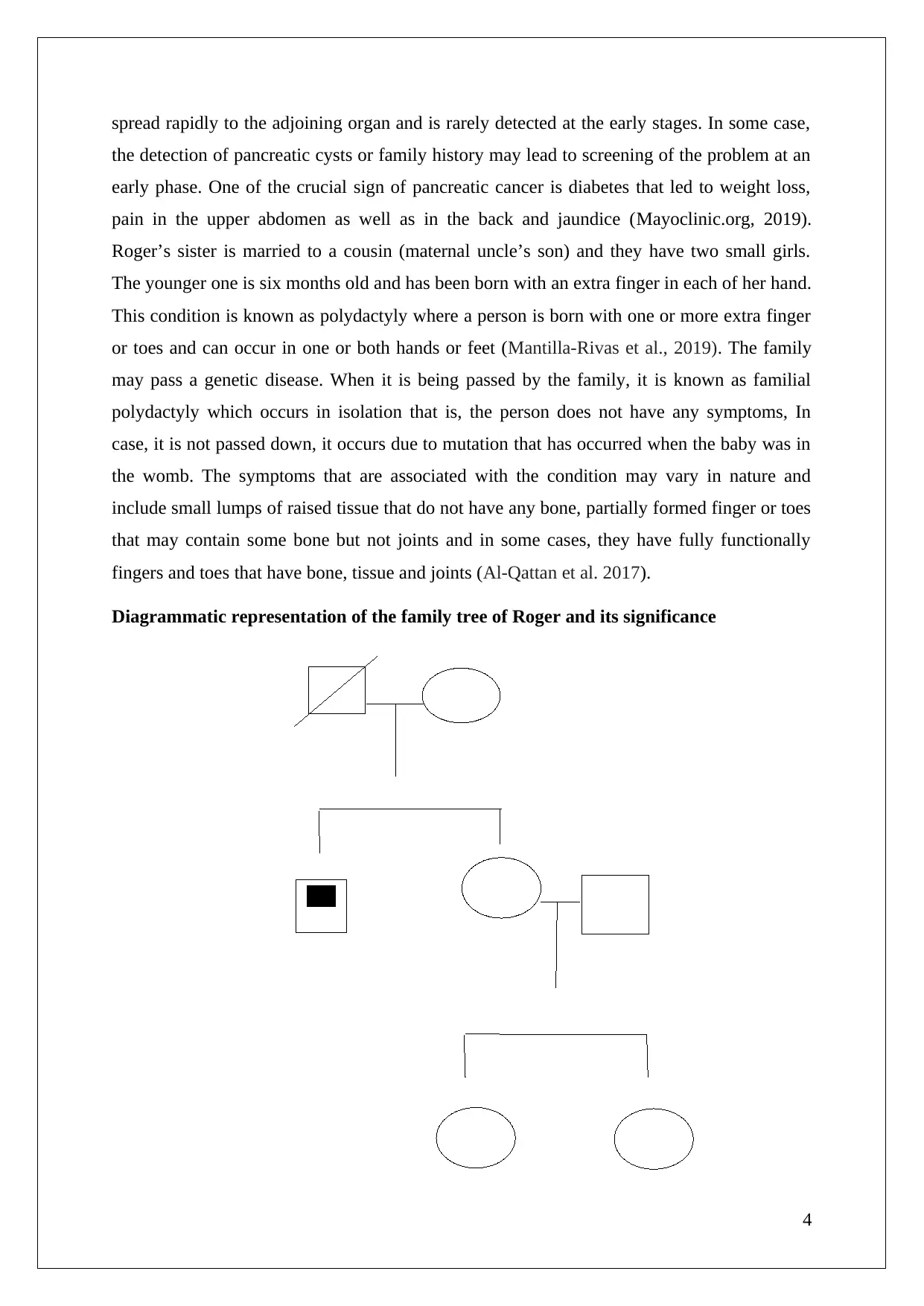
spread rapidly to the adjoining organ and is rarely detected at the early stages. In some case,
the detection of pancreatic cysts or family history may lead to screening of the problem at an
early phase. One of the crucial sign of pancreatic cancer is diabetes that led to weight loss,
pain in the upper abdomen as well as in the back and jaundice (Mayoclinic.org, 2019).
Roger’s sister is married to a cousin (maternal uncle’s son) and they have two small girls.
The younger one is six months old and has been born with an extra finger in each of her hand.
This condition is known as polydactyly where a person is born with one or more extra finger
or toes and can occur in one or both hands or feet (Mantilla-Rivas et al., 2019). The family
may pass a genetic disease. When it is being passed by the family, it is known as familial
polydactyly which occurs in isolation that is, the person does not have any symptoms, In
case, it is not passed down, it occurs due to mutation that has occurred when the baby was in
the womb. The symptoms that are associated with the condition may vary in nature and
include small lumps of raised tissue that do not have any bone, partially formed finger or toes
that may contain some bone but not joints and in some cases, they have fully functionally
fingers and toes that have bone, tissue and joints (Al‐Qattan et al. 2017).
Diagrammatic representation of the family tree of Roger and its significance
4
the detection of pancreatic cysts or family history may lead to screening of the problem at an
early phase. One of the crucial sign of pancreatic cancer is diabetes that led to weight loss,
pain in the upper abdomen as well as in the back and jaundice (Mayoclinic.org, 2019).
Roger’s sister is married to a cousin (maternal uncle’s son) and they have two small girls.
The younger one is six months old and has been born with an extra finger in each of her hand.
This condition is known as polydactyly where a person is born with one or more extra finger
or toes and can occur in one or both hands or feet (Mantilla-Rivas et al., 2019). The family
may pass a genetic disease. When it is being passed by the family, it is known as familial
polydactyly which occurs in isolation that is, the person does not have any symptoms, In
case, it is not passed down, it occurs due to mutation that has occurred when the baby was in
the womb. The symptoms that are associated with the condition may vary in nature and
include small lumps of raised tissue that do not have any bone, partially formed finger or toes
that may contain some bone but not joints and in some cases, they have fully functionally
fingers and toes that have bone, tissue and joints (Al‐Qattan et al. 2017).
Diagrammatic representation of the family tree of Roger and its significance
4
Paraphrase This Document
Need a fresh take? Get an instant paraphrase of this document with our AI Paraphraser
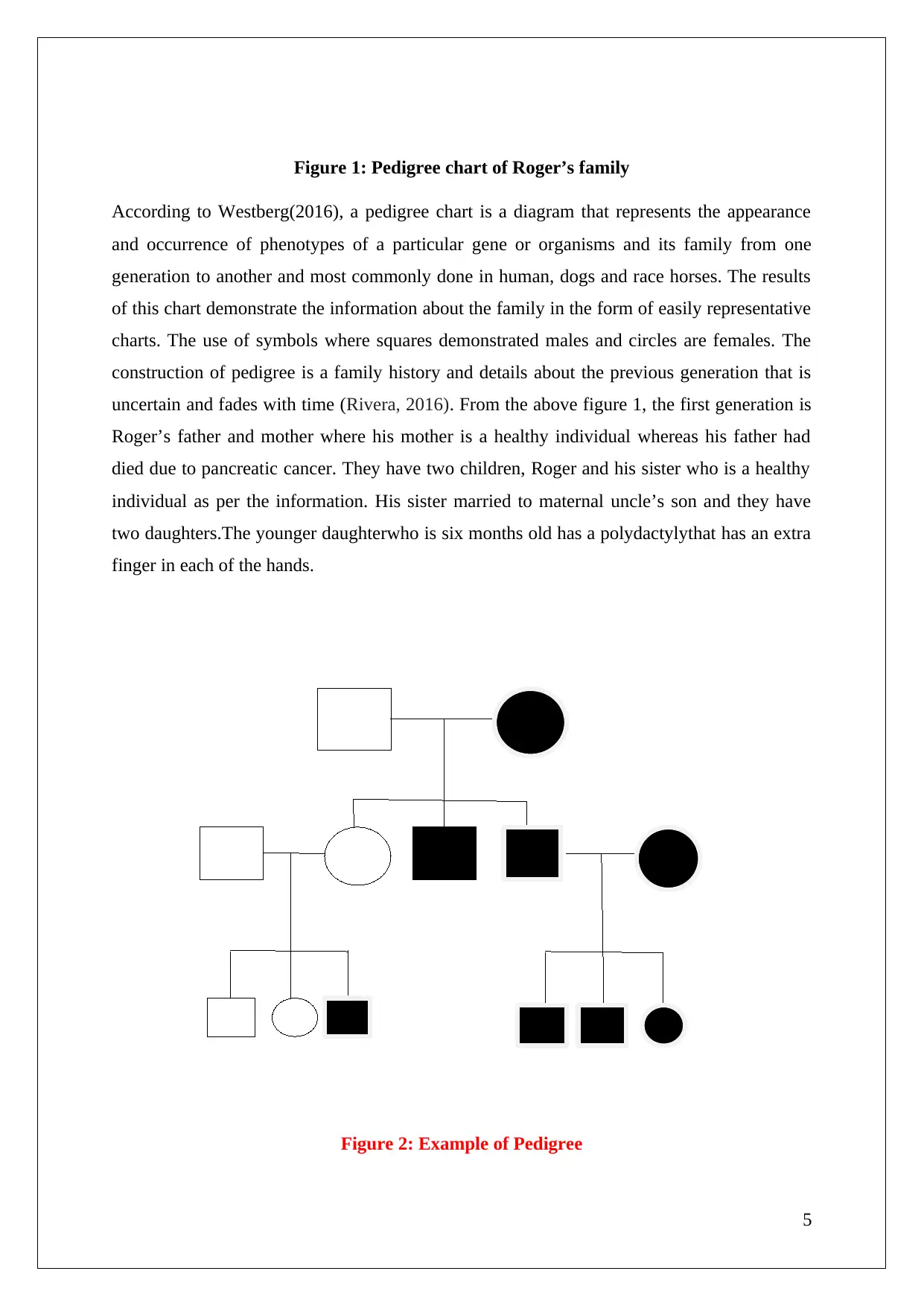
Figure 1: Pedigree chart of Roger’s family
According to Westberg(2016), a pedigree chart is a diagram that represents the appearance
and occurrence of phenotypes of a particular gene or organisms and its family from one
generation to another and most commonly done in human, dogs and race horses. The results
of this chart demonstrate the information about the family in the form of easily representative
charts. The use of symbols where squares demonstrated males and circles are females. The
construction of pedigree is a family history and details about the previous generation that is
uncertain and fades with time (Rivera, 2016). From the above figure 1, the first generation is
Roger’s father and mother where his mother is a healthy individual whereas his father had
died due to pancreatic cancer. They have two children, Roger and his sister who is a healthy
individual as per the information. His sister married to maternal uncle’s son and they have
two daughters.The younger daughterwho is six months old has a polydactylythat has an extra
finger in each of the hands.
Figure 2: Example of Pedigree
5
According to Westberg(2016), a pedigree chart is a diagram that represents the appearance
and occurrence of phenotypes of a particular gene or organisms and its family from one
generation to another and most commonly done in human, dogs and race horses. The results
of this chart demonstrate the information about the family in the form of easily representative
charts. The use of symbols where squares demonstrated males and circles are females. The
construction of pedigree is a family history and details about the previous generation that is
uncertain and fades with time (Rivera, 2016). From the above figure 1, the first generation is
Roger’s father and mother where his mother is a healthy individual whereas his father had
died due to pancreatic cancer. They have two children, Roger and his sister who is a healthy
individual as per the information. His sister married to maternal uncle’s son and they have
two daughters.The younger daughterwho is six months old has a polydactylythat has an extra
finger in each of the hands.
Figure 2: Example of Pedigree
5
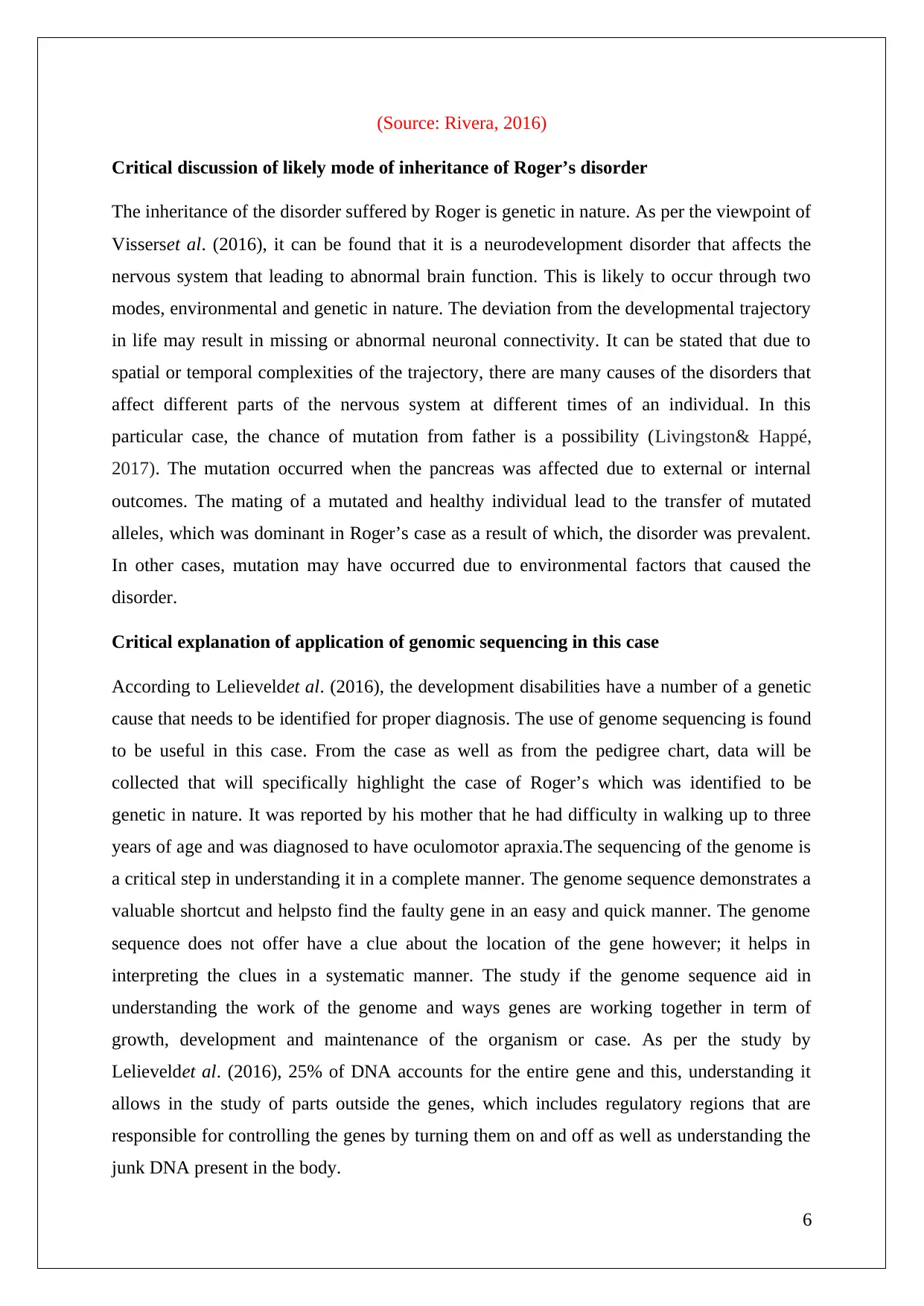
(Source: Rivera, 2016)
Critical discussion of likely mode of inheritance of Roger’s disorder
The inheritance of the disorder suffered by Roger is genetic in nature. As per the viewpoint of
Visserset al. (2016), it can be found that it is a neurodevelopment disorder that affects the
nervous system that leading to abnormal brain function. This is likely to occur through two
modes, environmental and genetic in nature. The deviation from the developmental trajectory
in life may result in missing or abnormal neuronal connectivity. It can be stated that due to
spatial or temporal complexities of the trajectory, there are many causes of the disorders that
affect different parts of the nervous system at different times of an individual. In this
particular case, the chance of mutation from father is a possibility (Livingston& Happé,
2017). The mutation occurred when the pancreas was affected due to external or internal
outcomes. The mating of a mutated and healthy individual lead to the transfer of mutated
alleles, which was dominant in Roger’s case as a result of which, the disorder was prevalent.
In other cases, mutation may have occurred due to environmental factors that caused the
disorder.
Critical explanation of application of genomic sequencing in this case
According to Lelieveldet al. (2016), the development disabilities have a number of a genetic
cause that needs to be identified for proper diagnosis. The use of genome sequencing is found
to be useful in this case. From the case as well as from the pedigree chart, data will be
collected that will specifically highlight the case of Roger’s which was identified to be
genetic in nature. It was reported by his mother that he had difficulty in walking up to three
years of age and was diagnosed to have oculomotor apraxia.The sequencing of the genome is
a critical step in understanding it in a complete manner. The genome sequence demonstrates a
valuable shortcut and helpsto find the faulty gene in an easy and quick manner. The genome
sequence does not offer have a clue about the location of the gene however; it helps in
interpreting the clues in a systematic manner. The study if the genome sequence aid in
understanding the work of the genome and ways genes are working together in term of
growth, development and maintenance of the organism or case. As per the study by
Lelieveldet al. (2016), 25% of DNA accounts for the entire gene and this, understanding it
allows in the study of parts outside the genes, which includes regulatory regions that are
responsible for controlling the genes by turning them on and off as well as understanding the
junk DNA present in the body.
6
Critical discussion of likely mode of inheritance of Roger’s disorder
The inheritance of the disorder suffered by Roger is genetic in nature. As per the viewpoint of
Visserset al. (2016), it can be found that it is a neurodevelopment disorder that affects the
nervous system that leading to abnormal brain function. This is likely to occur through two
modes, environmental and genetic in nature. The deviation from the developmental trajectory
in life may result in missing or abnormal neuronal connectivity. It can be stated that due to
spatial or temporal complexities of the trajectory, there are many causes of the disorders that
affect different parts of the nervous system at different times of an individual. In this
particular case, the chance of mutation from father is a possibility (Livingston& Happé,
2017). The mutation occurred when the pancreas was affected due to external or internal
outcomes. The mating of a mutated and healthy individual lead to the transfer of mutated
alleles, which was dominant in Roger’s case as a result of which, the disorder was prevalent.
In other cases, mutation may have occurred due to environmental factors that caused the
disorder.
Critical explanation of application of genomic sequencing in this case
According to Lelieveldet al. (2016), the development disabilities have a number of a genetic
cause that needs to be identified for proper diagnosis. The use of genome sequencing is found
to be useful in this case. From the case as well as from the pedigree chart, data will be
collected that will specifically highlight the case of Roger’s which was identified to be
genetic in nature. It was reported by his mother that he had difficulty in walking up to three
years of age and was diagnosed to have oculomotor apraxia.The sequencing of the genome is
a critical step in understanding it in a complete manner. The genome sequence demonstrates a
valuable shortcut and helpsto find the faulty gene in an easy and quick manner. The genome
sequence does not offer have a clue about the location of the gene however; it helps in
interpreting the clues in a systematic manner. The study if the genome sequence aid in
understanding the work of the genome and ways genes are working together in term of
growth, development and maintenance of the organism or case. As per the study by
Lelieveldet al. (2016), 25% of DNA accounts for the entire gene and this, understanding it
allows in the study of parts outside the genes, which includes regulatory regions that are
responsible for controlling the genes by turning them on and off as well as understanding the
junk DNA present in the body.
6
⊘ This is a preview!⊘
Do you want full access?
Subscribe today to unlock all pages.

Trusted by 1+ million students worldwide
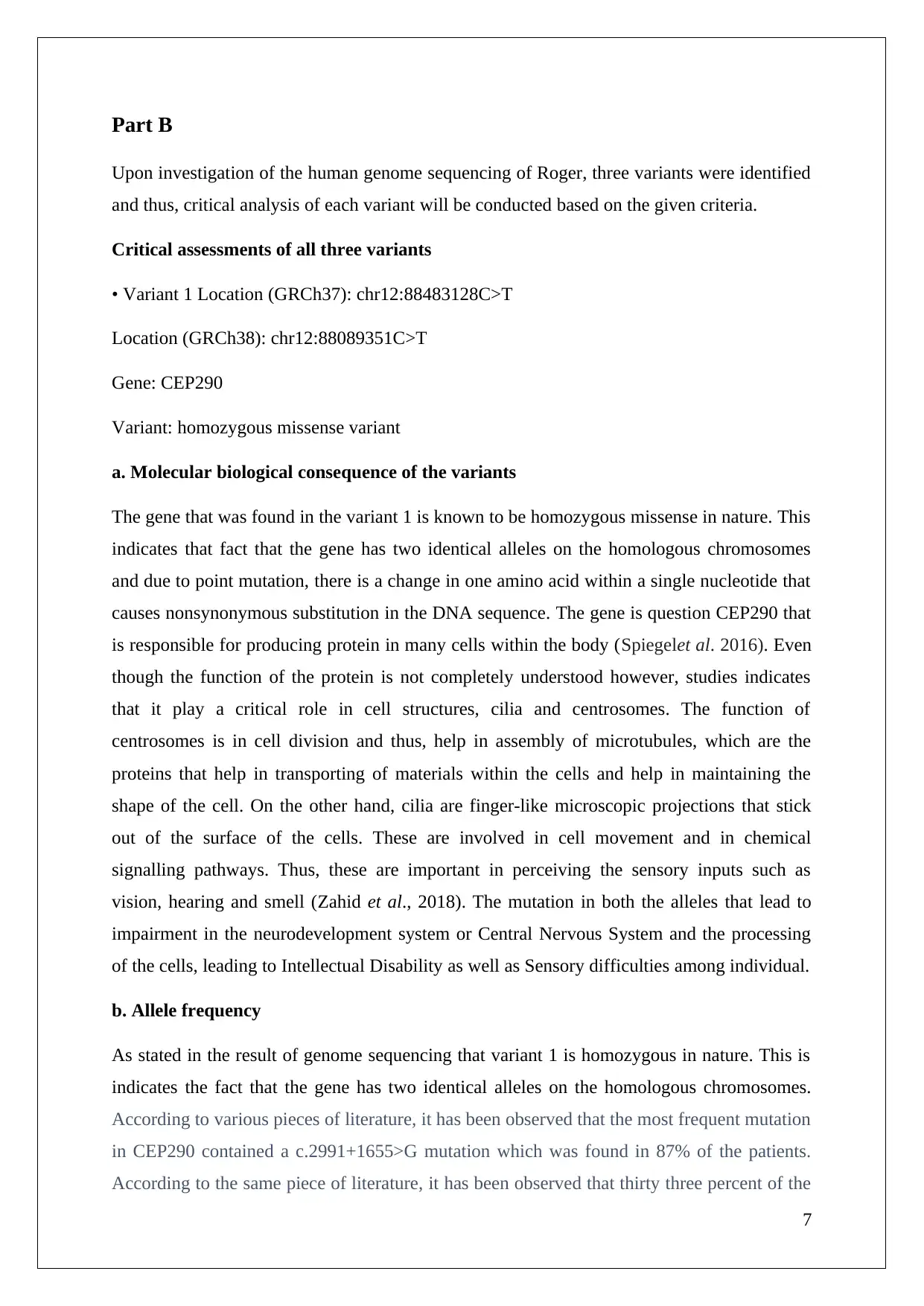
Part B
Upon investigation of the human genome sequencing of Roger, three variants were identified
and thus, critical analysis of each variant will be conducted based on the given criteria.
Critical assessments of all three variants
• Variant 1 Location (GRCh37): chr12:88483128C>T
Location (GRCh38): chr12:88089351C>T
Gene: CEP290
Variant: homozygous missense variant
a. Molecular biological consequence of the variants
The gene that was found in the variant 1 is known to be homozygous missense in nature. This
indicates that fact that the gene has two identical alleles on the homologous chromosomes
and due to point mutation, there is a change in one amino acid within a single nucleotide that
causes nonsynonymous substitution in the DNA sequence. The gene is question CEP290 that
is responsible for producing protein in many cells within the body (Spiegelet al. 2016). Even
though the function of the protein is not completely understood however, studies indicates
that it play a critical role in cell structures, cilia and centrosomes. The function of
centrosomes is in cell division and thus, help in assembly of microtubules, which are the
proteins that help in transporting of materials within the cells and help in maintaining the
shape of the cell. On the other hand, cilia are finger-like microscopic projections that stick
out of the surface of the cells. These are involved in cell movement and in chemical
signalling pathways. Thus, these are important in perceiving the sensory inputs such as
vision, hearing and smell (Zahid et al., 2018). The mutation in both the alleles that lead to
impairment in the neurodevelopment system or Central Nervous System and the processing
of the cells, leading to Intellectual Disability as well as Sensory difficulties among individual.
b. Allele frequency
As stated in the result of genome sequencing that variant 1 is homozygous in nature. This is
indicates the fact that the gene has two identical alleles on the homologous chromosomes.
According to various pieces of literature, it has been observed that the most frequent mutation
in CEP290 contained a c.2991+1655>G mutation which was found in 87% of the patients.
According to the same piece of literature, it has been observed that thirty three percent of the
7
Upon investigation of the human genome sequencing of Roger, three variants were identified
and thus, critical analysis of each variant will be conducted based on the given criteria.
Critical assessments of all three variants
• Variant 1 Location (GRCh37): chr12:88483128C>T
Location (GRCh38): chr12:88089351C>T
Gene: CEP290
Variant: homozygous missense variant
a. Molecular biological consequence of the variants
The gene that was found in the variant 1 is known to be homozygous missense in nature. This
indicates that fact that the gene has two identical alleles on the homologous chromosomes
and due to point mutation, there is a change in one amino acid within a single nucleotide that
causes nonsynonymous substitution in the DNA sequence. The gene is question CEP290 that
is responsible for producing protein in many cells within the body (Spiegelet al. 2016). Even
though the function of the protein is not completely understood however, studies indicates
that it play a critical role in cell structures, cilia and centrosomes. The function of
centrosomes is in cell division and thus, help in assembly of microtubules, which are the
proteins that help in transporting of materials within the cells and help in maintaining the
shape of the cell. On the other hand, cilia are finger-like microscopic projections that stick
out of the surface of the cells. These are involved in cell movement and in chemical
signalling pathways. Thus, these are important in perceiving the sensory inputs such as
vision, hearing and smell (Zahid et al., 2018). The mutation in both the alleles that lead to
impairment in the neurodevelopment system or Central Nervous System and the processing
of the cells, leading to Intellectual Disability as well as Sensory difficulties among individual.
b. Allele frequency
As stated in the result of genome sequencing that variant 1 is homozygous in nature. This is
indicates the fact that the gene has two identical alleles on the homologous chromosomes.
According to various pieces of literature, it has been observed that the most frequent mutation
in CEP290 contained a c.2991+1655>G mutation which was found in 87% of the patients.
According to the same piece of literature, it has been observed that thirty three percent of the
7
Paraphrase This Document
Need a fresh take? Get an instant paraphrase of this document with our AI Paraphraser
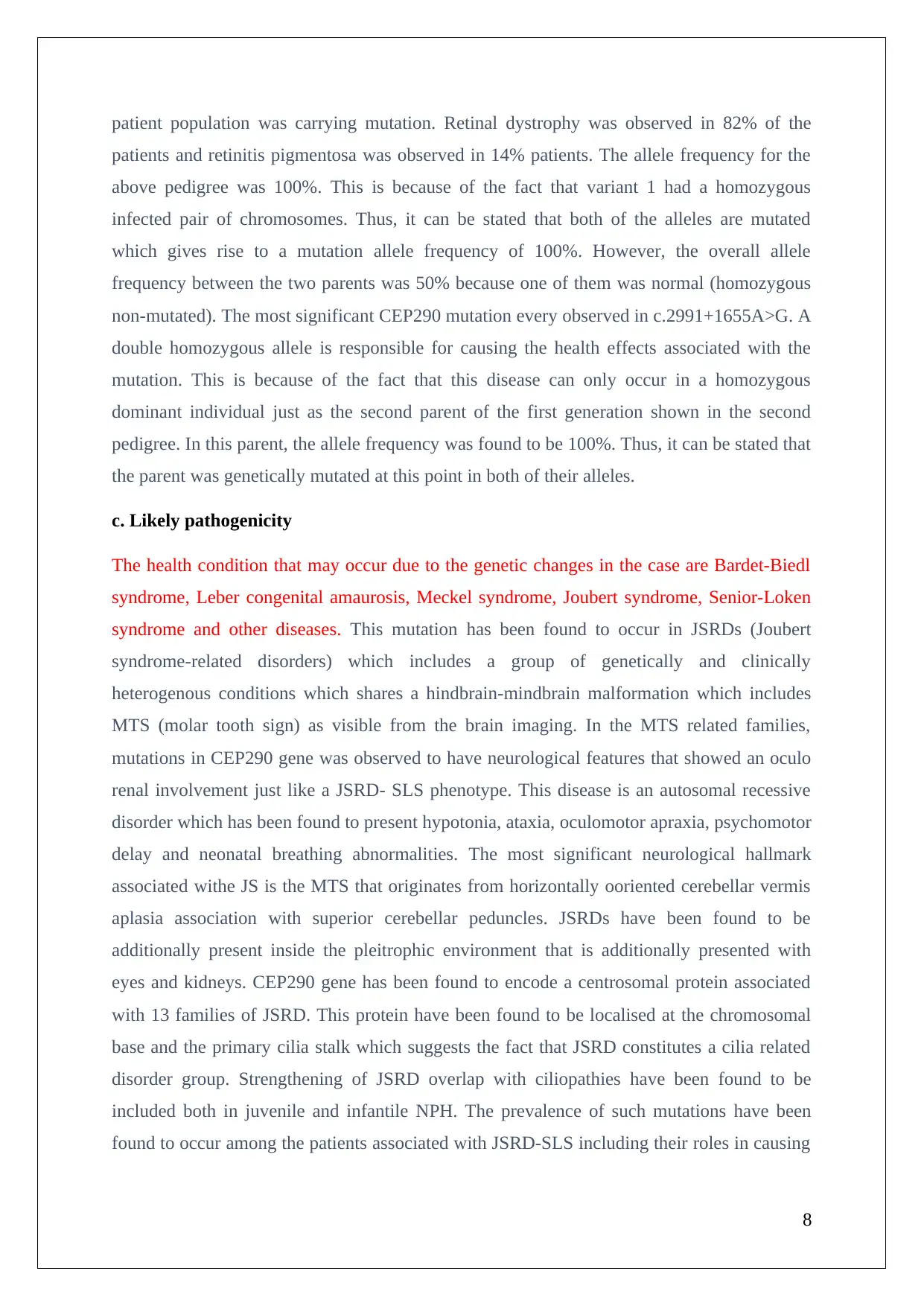
patient population was carrying mutation. Retinal dystrophy was observed in 82% of the
patients and retinitis pigmentosa was observed in 14% patients. The allele frequency for the
above pedigree was 100%. This is because of the fact that variant 1 had a homozygous
infected pair of chromosomes. Thus, it can be stated that both of the alleles are mutated
which gives rise to a mutation allele frequency of 100%. However, the overall allele
frequency between the two parents was 50% because one of them was normal (homozygous
non-mutated). The most significant CEP290 mutation every observed in c.2991+1655A>G. A
double homozygous allele is responsible for causing the health effects associated with the
mutation. This is because of the fact that this disease can only occur in a homozygous
dominant individual just as the second parent of the first generation shown in the second
pedigree. In this parent, the allele frequency was found to be 100%. Thus, it can be stated that
the parent was genetically mutated at this point in both of their alleles.
c. Likely pathogenicity
The health condition that may occur due to the genetic changes in the case are Bardet-Biedl
syndrome, Leber congenital amaurosis, Meckel syndrome, Joubert syndrome, Senior-Loken
syndrome and other diseases. This mutation has been found to occur in JSRDs (Joubert
syndrome-related disorders) which includes a group of genetically and clinically
heterogenous conditions which shares a hindbrain-mindbrain malformation which includes
MTS (molar tooth sign) as visible from the brain imaging. In the MTS related families,
mutations in CEP290 gene was observed to have neurological features that showed an oculo
renal involvement just like a JSRD- SLS phenotype. This disease is an autosomal recessive
disorder which has been found to present hypotonia, ataxia, oculomotor apraxia, psychomotor
delay and neonatal breathing abnormalities. The most significant neurological hallmark
associated withe JS is the MTS that originates from horizontally ooriented cerebellar vermis
aplasia association with superior cerebellar peduncles. JSRDs have been found to be
additionally present inside the pleitrophic environment that is additionally presented with
eyes and kidneys. CEP290 gene has been found to encode a centrosomal protein associated
with 13 families of JSRD. This protein have been found to be localised at the chromosomal
base and the primary cilia stalk which suggests the fact that JSRD constitutes a cilia related
disorder group. Strengthening of JSRD overlap with ciliopathies have been found to be
included both in juvenile and infantile NPH. The prevalence of such mutations have been
found to occur among the patients associated with JSRD-SLS including their roles in causing
8
patients and retinitis pigmentosa was observed in 14% patients. The allele frequency for the
above pedigree was 100%. This is because of the fact that variant 1 had a homozygous
infected pair of chromosomes. Thus, it can be stated that both of the alleles are mutated
which gives rise to a mutation allele frequency of 100%. However, the overall allele
frequency between the two parents was 50% because one of them was normal (homozygous
non-mutated). The most significant CEP290 mutation every observed in c.2991+1655A>G. A
double homozygous allele is responsible for causing the health effects associated with the
mutation. This is because of the fact that this disease can only occur in a homozygous
dominant individual just as the second parent of the first generation shown in the second
pedigree. In this parent, the allele frequency was found to be 100%. Thus, it can be stated that
the parent was genetically mutated at this point in both of their alleles.
c. Likely pathogenicity
The health condition that may occur due to the genetic changes in the case are Bardet-Biedl
syndrome, Leber congenital amaurosis, Meckel syndrome, Joubert syndrome, Senior-Loken
syndrome and other diseases. This mutation has been found to occur in JSRDs (Joubert
syndrome-related disorders) which includes a group of genetically and clinically
heterogenous conditions which shares a hindbrain-mindbrain malformation which includes
MTS (molar tooth sign) as visible from the brain imaging. In the MTS related families,
mutations in CEP290 gene was observed to have neurological features that showed an oculo
renal involvement just like a JSRD- SLS phenotype. This disease is an autosomal recessive
disorder which has been found to present hypotonia, ataxia, oculomotor apraxia, psychomotor
delay and neonatal breathing abnormalities. The most significant neurological hallmark
associated withe JS is the MTS that originates from horizontally ooriented cerebellar vermis
aplasia association with superior cerebellar peduncles. JSRDs have been found to be
additionally present inside the pleitrophic environment that is additionally presented with
eyes and kidneys. CEP290 gene has been found to encode a centrosomal protein associated
with 13 families of JSRD. This protein have been found to be localised at the chromosomal
base and the primary cilia stalk which suggests the fact that JSRD constitutes a cilia related
disorder group. Strengthening of JSRD overlap with ciliopathies have been found to be
included both in juvenile and infantile NPH. The prevalence of such mutations have been
found to occur among the patients associated with JSRD-SLS including their roles in causing
8
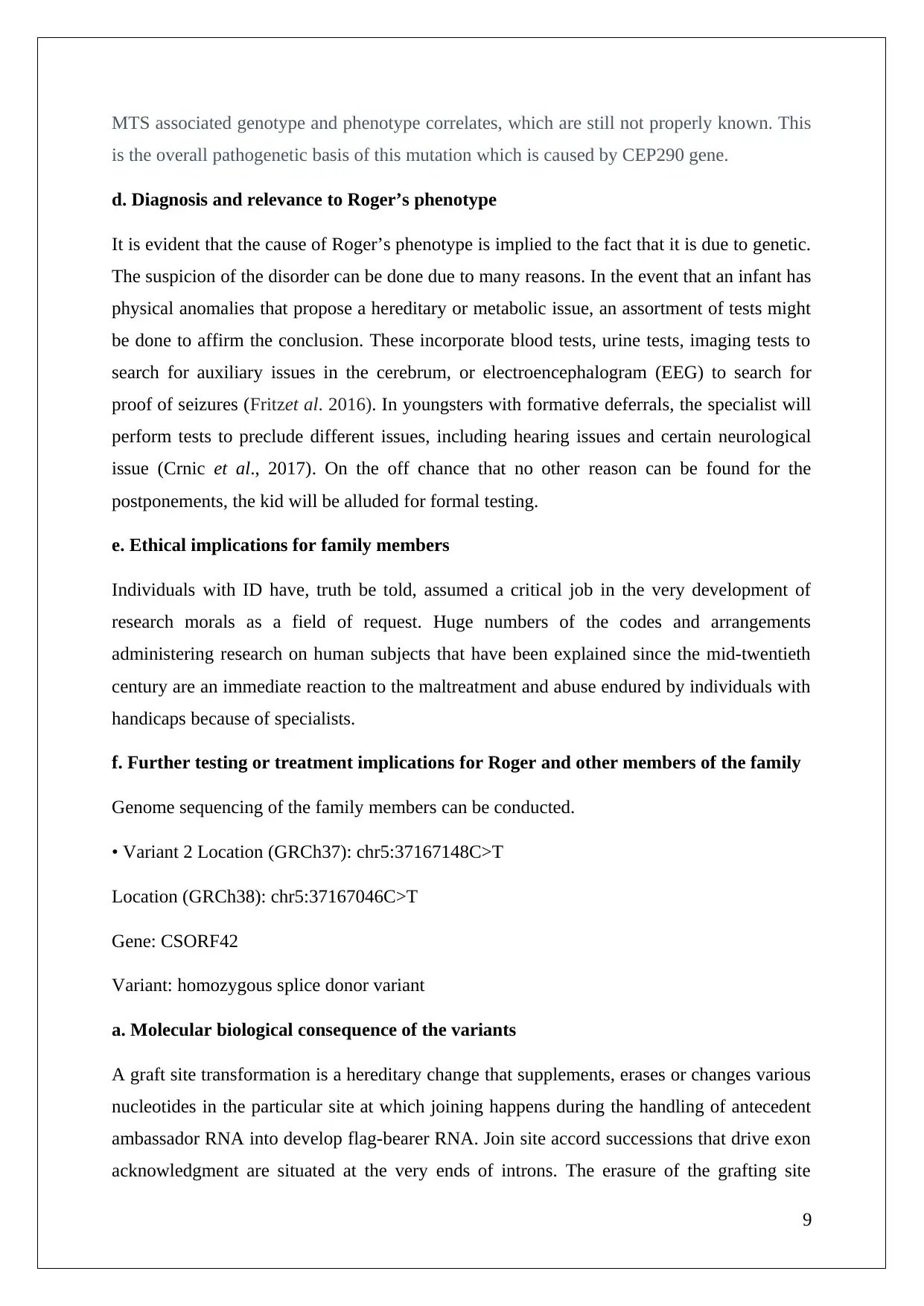
MTS associated genotype and phenotype correlates, which are still not properly known. This
is the overall pathogenetic basis of this mutation which is caused by CEP290 gene.
d. Diagnosis and relevance to Roger’s phenotype
It is evident that the cause of Roger’s phenotype is implied to the fact that it is due to genetic.
The suspicion of the disorder can be done due to many reasons. In the event that an infant has
physical anomalies that propose a hereditary or metabolic issue, an assortment of tests might
be done to affirm the conclusion. These incorporate blood tests, urine tests, imaging tests to
search for auxiliary issues in the cerebrum, or electroencephalogram (EEG) to search for
proof of seizures (Fritzet al. 2016). In youngsters with formative deferrals, the specialist will
perform tests to preclude different issues, including hearing issues and certain neurological
issue (Crnic et al., 2017). On the off chance that no other reason can be found for the
postponements, the kid will be alluded for formal testing.
e. Ethical implications for family members
Individuals with ID have, truth be told, assumed a critical job in the very development of
research morals as a field of request. Huge numbers of the codes and arrangements
administering research on human subjects that have been explained since the mid-twentieth
century are an immediate reaction to the maltreatment and abuse endured by individuals with
handicaps because of specialists.
f. Further testing or treatment implications for Roger and other members of the family
Genome sequencing of the family members can be conducted.
• Variant 2 Location (GRCh37): chr5:37167148C>T
Location (GRCh38): chr5:37167046C>T
Gene: CSORF42
Variant: homozygous splice donor variant
a. Molecular biological consequence of the variants
A graft site transformation is a hereditary change that supplements, erases or changes various
nucleotides in the particular site at which joining happens during the handling of antecedent
ambassador RNA into develop flag-bearer RNA. Join site accord successions that drive exon
acknowledgment are situated at the very ends of introns. The erasure of the grafting site
9
is the overall pathogenetic basis of this mutation which is caused by CEP290 gene.
d. Diagnosis and relevance to Roger’s phenotype
It is evident that the cause of Roger’s phenotype is implied to the fact that it is due to genetic.
The suspicion of the disorder can be done due to many reasons. In the event that an infant has
physical anomalies that propose a hereditary or metabolic issue, an assortment of tests might
be done to affirm the conclusion. These incorporate blood tests, urine tests, imaging tests to
search for auxiliary issues in the cerebrum, or electroencephalogram (EEG) to search for
proof of seizures (Fritzet al. 2016). In youngsters with formative deferrals, the specialist will
perform tests to preclude different issues, including hearing issues and certain neurological
issue (Crnic et al., 2017). On the off chance that no other reason can be found for the
postponements, the kid will be alluded for formal testing.
e. Ethical implications for family members
Individuals with ID have, truth be told, assumed a critical job in the very development of
research morals as a field of request. Huge numbers of the codes and arrangements
administering research on human subjects that have been explained since the mid-twentieth
century are an immediate reaction to the maltreatment and abuse endured by individuals with
handicaps because of specialists.
f. Further testing or treatment implications for Roger and other members of the family
Genome sequencing of the family members can be conducted.
• Variant 2 Location (GRCh37): chr5:37167148C>T
Location (GRCh38): chr5:37167046C>T
Gene: CSORF42
Variant: homozygous splice donor variant
a. Molecular biological consequence of the variants
A graft site transformation is a hereditary change that supplements, erases or changes various
nucleotides in the particular site at which joining happens during the handling of antecedent
ambassador RNA into develop flag-bearer RNA. Join site accord successions that drive exon
acknowledgment are situated at the very ends of introns. The erasure of the grafting site
9
⊘ This is a preview!⊘
Do you want full access?
Subscribe today to unlock all pages.

Trusted by 1+ million students worldwide
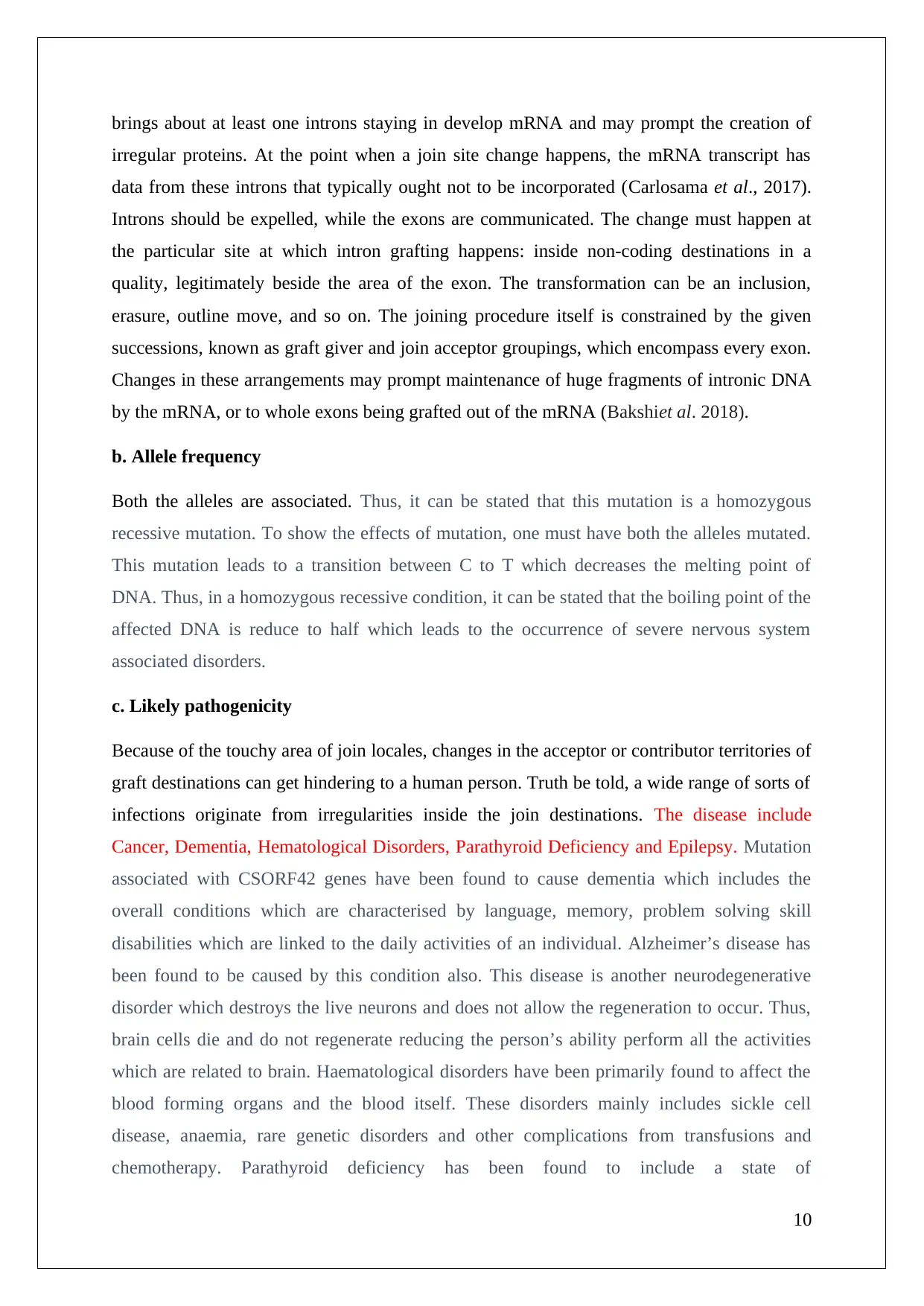
brings about at least one introns staying in develop mRNA and may prompt the creation of
irregular proteins. At the point when a join site change happens, the mRNA transcript has
data from these introns that typically ought not to be incorporated (Carlosama et al., 2017).
Introns should be expelled, while the exons are communicated. The change must happen at
the particular site at which intron grafting happens: inside non-coding destinations in a
quality, legitimately beside the area of the exon. The transformation can be an inclusion,
erasure, outline move, and so on. The joining procedure itself is constrained by the given
successions, known as graft giver and join acceptor groupings, which encompass every exon.
Changes in these arrangements may prompt maintenance of huge fragments of intronic DNA
by the mRNA, or to whole exons being grafted out of the mRNA (Bakshiet al. 2018).
b. Allele frequency
Both the alleles are associated. Thus, it can be stated that this mutation is a homozygous
recessive mutation. To show the effects of mutation, one must have both the alleles mutated.
This mutation leads to a transition between C to T which decreases the melting point of
DNA. Thus, in a homozygous recessive condition, it can be stated that the boiling point of the
affected DNA is reduce to half which leads to the occurrence of severe nervous system
associated disorders.
c. Likely pathogenicity
Because of the touchy area of join locales, changes in the acceptor or contributor territories of
graft destinations can get hindering to a human person. Truth be told, a wide range of sorts of
infections originate from irregularities inside the join destinations. The disease include
Cancer, Dementia, Hematological Disorders, Parathyroid Deficiency and Epilepsy. Mutation
associated with CSORF42 genes have been found to cause dementia which includes the
overall conditions which are characterised by language, memory, problem solving skill
disabilities which are linked to the daily activities of an individual. Alzheimer’s disease has
been found to be caused by this condition also. This disease is another neurodegenerative
disorder which destroys the live neurons and does not allow the regeneration to occur. Thus,
brain cells die and do not regenerate reducing the person’s ability perform all the activities
which are related to brain. Haematological disorders have been primarily found to affect the
blood forming organs and the blood itself. These disorders mainly includes sickle cell
disease, anaemia, rare genetic disorders and other complications from transfusions and
chemotherapy. Parathyroid deficiency has been found to include a state of
10
irregular proteins. At the point when a join site change happens, the mRNA transcript has
data from these introns that typically ought not to be incorporated (Carlosama et al., 2017).
Introns should be expelled, while the exons are communicated. The change must happen at
the particular site at which intron grafting happens: inside non-coding destinations in a
quality, legitimately beside the area of the exon. The transformation can be an inclusion,
erasure, outline move, and so on. The joining procedure itself is constrained by the given
successions, known as graft giver and join acceptor groupings, which encompass every exon.
Changes in these arrangements may prompt maintenance of huge fragments of intronic DNA
by the mRNA, or to whole exons being grafted out of the mRNA (Bakshiet al. 2018).
b. Allele frequency
Both the alleles are associated. Thus, it can be stated that this mutation is a homozygous
recessive mutation. To show the effects of mutation, one must have both the alleles mutated.
This mutation leads to a transition between C to T which decreases the melting point of
DNA. Thus, in a homozygous recessive condition, it can be stated that the boiling point of the
affected DNA is reduce to half which leads to the occurrence of severe nervous system
associated disorders.
c. Likely pathogenicity
Because of the touchy area of join locales, changes in the acceptor or contributor territories of
graft destinations can get hindering to a human person. Truth be told, a wide range of sorts of
infections originate from irregularities inside the join destinations. The disease include
Cancer, Dementia, Hematological Disorders, Parathyroid Deficiency and Epilepsy. Mutation
associated with CSORF42 genes have been found to cause dementia which includes the
overall conditions which are characterised by language, memory, problem solving skill
disabilities which are linked to the daily activities of an individual. Alzheimer’s disease has
been found to be caused by this condition also. This disease is another neurodegenerative
disorder which destroys the live neurons and does not allow the regeneration to occur. Thus,
brain cells die and do not regenerate reducing the person’s ability perform all the activities
which are related to brain. Haematological disorders have been primarily found to affect the
blood forming organs and the blood itself. These disorders mainly includes sickle cell
disease, anaemia, rare genetic disorders and other complications from transfusions and
chemotherapy. Parathyroid deficiency has been found to include a state of
10
Paraphrase This Document
Need a fresh take? Get an instant paraphrase of this document with our AI Paraphraser
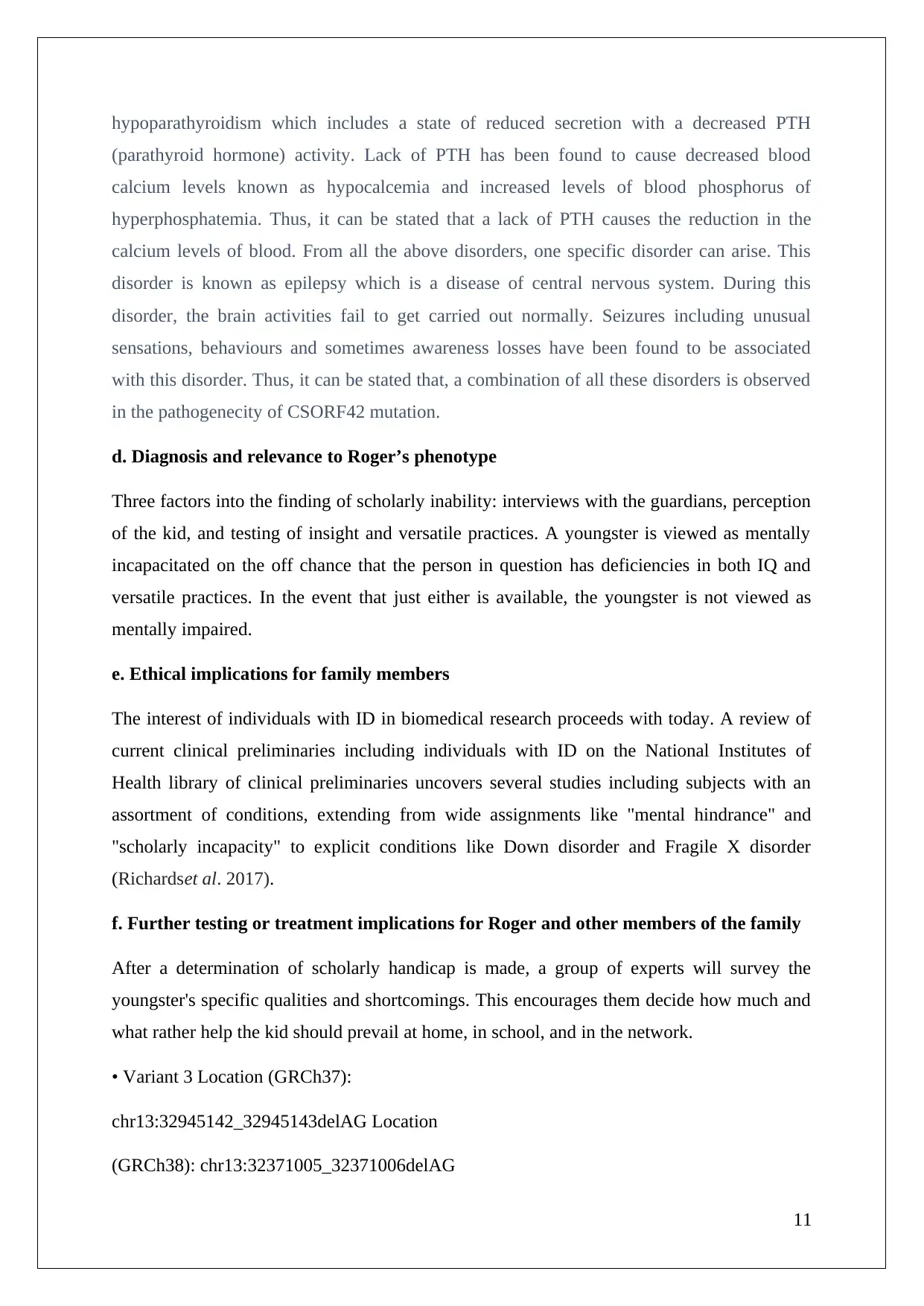
hypoparathyroidism which includes a state of reduced secretion with a decreased PTH
(parathyroid hormone) activity. Lack of PTH has been found to cause decreased blood
calcium levels known as hypocalcemia and increased levels of blood phosphorus of
hyperphosphatemia. Thus, it can be stated that a lack of PTH causes the reduction in the
calcium levels of blood. From all the above disorders, one specific disorder can arise. This
disorder is known as epilepsy which is a disease of central nervous system. During this
disorder, the brain activities fail to get carried out normally. Seizures including unusual
sensations, behaviours and sometimes awareness losses have been found to be associated
with this disorder. Thus, it can be stated that, a combination of all these disorders is observed
in the pathogenecity of CSORF42 mutation.
d. Diagnosis and relevance to Roger’s phenotype
Three factors into the finding of scholarly inability: interviews with the guardians, perception
of the kid, and testing of insight and versatile practices. A youngster is viewed as mentally
incapacitated on the off chance that the person in question has deficiencies in both IQ and
versatile practices. In the event that just either is available, the youngster is not viewed as
mentally impaired.
e. Ethical implications for family members
The interest of individuals with ID in biomedical research proceeds with today. A review of
current clinical preliminaries including individuals with ID on the National Institutes of
Health library of clinical preliminaries uncovers several studies including subjects with an
assortment of conditions, extending from wide assignments like "mental hindrance" and
"scholarly incapacity" to explicit conditions like Down disorder and Fragile X disorder
(Richardset al. 2017).
f. Further testing or treatment implications for Roger and other members of the family
After a determination of scholarly handicap is made, a group of experts will survey the
youngster's specific qualities and shortcomings. This encourages them decide how much and
what rather help the kid should prevail at home, in school, and in the network.
• Variant 3 Location (GRCh37):
chr13:32945142_32945143delAG Location
(GRCh38): chr13:32371005_32371006delAG
11
(parathyroid hormone) activity. Lack of PTH has been found to cause decreased blood
calcium levels known as hypocalcemia and increased levels of blood phosphorus of
hyperphosphatemia. Thus, it can be stated that a lack of PTH causes the reduction in the
calcium levels of blood. From all the above disorders, one specific disorder can arise. This
disorder is known as epilepsy which is a disease of central nervous system. During this
disorder, the brain activities fail to get carried out normally. Seizures including unusual
sensations, behaviours and sometimes awareness losses have been found to be associated
with this disorder. Thus, it can be stated that, a combination of all these disorders is observed
in the pathogenecity of CSORF42 mutation.
d. Diagnosis and relevance to Roger’s phenotype
Three factors into the finding of scholarly inability: interviews with the guardians, perception
of the kid, and testing of insight and versatile practices. A youngster is viewed as mentally
incapacitated on the off chance that the person in question has deficiencies in both IQ and
versatile practices. In the event that just either is available, the youngster is not viewed as
mentally impaired.
e. Ethical implications for family members
The interest of individuals with ID in biomedical research proceeds with today. A review of
current clinical preliminaries including individuals with ID on the National Institutes of
Health library of clinical preliminaries uncovers several studies including subjects with an
assortment of conditions, extending from wide assignments like "mental hindrance" and
"scholarly incapacity" to explicit conditions like Down disorder and Fragile X disorder
(Richardset al. 2017).
f. Further testing or treatment implications for Roger and other members of the family
After a determination of scholarly handicap is made, a group of experts will survey the
youngster's specific qualities and shortcomings. This encourages them decide how much and
what rather help the kid should prevail at home, in school, and in the network.
• Variant 3 Location (GRCh37):
chr13:32945142_32945143delAG Location
(GRCh38): chr13:32371005_32371006delAG
11
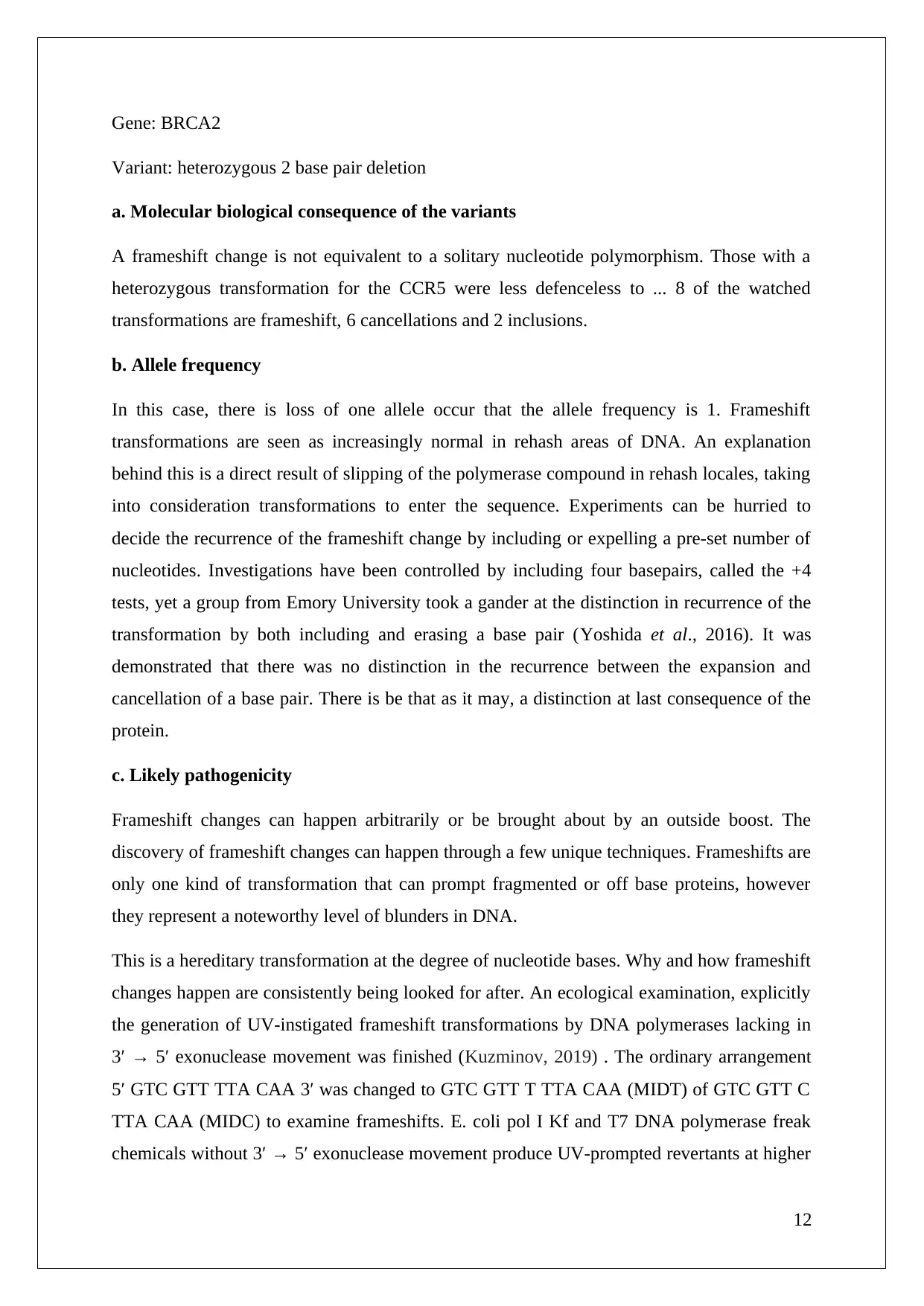
Gene: BRCA2
Variant: heterozygous 2 base pair deletion
a. Molecular biological consequence of the variants
A frameshift change is not equivalent to a solitary nucleotide polymorphism. Those with a
heterozygous transformation for the CCR5 were less defenceless to ... 8 of the watched
transformations are frameshift, 6 cancellations and 2 inclusions.
b. Allele frequency
In this case, there is loss of one allele occur that the allele frequency is 1. Frameshift
transformations are seen as increasingly normal in rehash areas of DNA. An explanation
behind this is a direct result of slipping of the polymerase compound in rehash locales, taking
into consideration transformations to enter the sequence. Experiments can be hurried to
decide the recurrence of the frameshift change by including or expelling a pre-set number of
nucleotides. Investigations have been controlled by including four basepairs, called the +4
tests, yet a group from Emory University took a gander at the distinction in recurrence of the
transformation by both including and erasing a base pair (Yoshida et al., 2016). It was
demonstrated that there was no distinction in the recurrence between the expansion and
cancellation of a base pair. There is be that as it may, a distinction at last consequence of the
protein.
c. Likely pathogenicity
Frameshift changes can happen arbitrarily or be brought about by an outside boost. The
discovery of frameshift changes can happen through a few unique techniques. Frameshifts are
only one kind of transformation that can prompt fragmented or off base proteins, however
they represent a noteworthy level of blunders in DNA.
This is a hereditary transformation at the degree of nucleotide bases. Why and how frameshift
changes happen are consistently being looked for after. An ecological examination, explicitly
the generation of UV-instigated frameshift transformations by DNA polymerases lacking in
3′ → 5′ exonuclease movement was finished (Kuzminov, 2019) . The ordinary arrangement
5′ GTC GTT TTA CAA 3′ was changed to GTC GTT T TTA CAA (MIDT) of GTC GTT C
TTA CAA (MIDC) to examine frameshifts. E. coli pol I Kf and T7 DNA polymerase freak
chemicals without 3′ → 5′ exonuclease movement produce UV-prompted revertants at higher
12
Variant: heterozygous 2 base pair deletion
a. Molecular biological consequence of the variants
A frameshift change is not equivalent to a solitary nucleotide polymorphism. Those with a
heterozygous transformation for the CCR5 were less defenceless to ... 8 of the watched
transformations are frameshift, 6 cancellations and 2 inclusions.
b. Allele frequency
In this case, there is loss of one allele occur that the allele frequency is 1. Frameshift
transformations are seen as increasingly normal in rehash areas of DNA. An explanation
behind this is a direct result of slipping of the polymerase compound in rehash locales, taking
into consideration transformations to enter the sequence. Experiments can be hurried to
decide the recurrence of the frameshift change by including or expelling a pre-set number of
nucleotides. Investigations have been controlled by including four basepairs, called the +4
tests, yet a group from Emory University took a gander at the distinction in recurrence of the
transformation by both including and erasing a base pair (Yoshida et al., 2016). It was
demonstrated that there was no distinction in the recurrence between the expansion and
cancellation of a base pair. There is be that as it may, a distinction at last consequence of the
protein.
c. Likely pathogenicity
Frameshift changes can happen arbitrarily or be brought about by an outside boost. The
discovery of frameshift changes can happen through a few unique techniques. Frameshifts are
only one kind of transformation that can prompt fragmented or off base proteins, however
they represent a noteworthy level of blunders in DNA.
This is a hereditary transformation at the degree of nucleotide bases. Why and how frameshift
changes happen are consistently being looked for after. An ecological examination, explicitly
the generation of UV-instigated frameshift transformations by DNA polymerases lacking in
3′ → 5′ exonuclease movement was finished (Kuzminov, 2019) . The ordinary arrangement
5′ GTC GTT TTA CAA 3′ was changed to GTC GTT T TTA CAA (MIDT) of GTC GTT C
TTA CAA (MIDC) to examine frameshifts. E. coli pol I Kf and T7 DNA polymerase freak
chemicals without 3′ → 5′ exonuclease movement produce UV-prompted revertants at higher
12
⊘ This is a preview!⊘
Do you want full access?
Subscribe today to unlock all pages.

Trusted by 1+ million students worldwide
1 out of 16
Your All-in-One AI-Powered Toolkit for Academic Success.
+13062052269
info@desklib.com
Available 24*7 on WhatsApp / Email
![[object Object]](/_next/static/media/star-bottom.7253800d.svg)
Unlock your academic potential
Copyright © 2020–2025 A2Z Services. All Rights Reserved. Developed and managed by ZUCOL.

